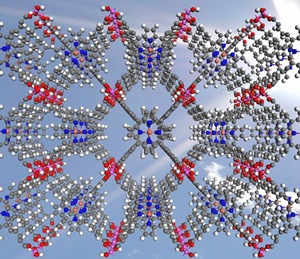Material inspired by nature could turn water into fuel
Release Date 20 October 2015

Scientists have theoretically designed a new material that could help supply the world with clean energy by turning water into fuel, using just the power of the sun.
Chemists at the University of Reading say a new catalyst, which mimics the way plants absorb energy from the sun, could make the energy-sapping job of splitting water into hydrogen and oxygen relatively easy.
As well as potentially being able to produce hydrogen for fuel cells, the complex new material could also be used to turn carbon dioxide from the air into a carbon-based fuel, such as methanol.
Dr Ricardo Grau-Crespo, from the Chemistry Department of the University of Reading, led the team that made the discovery.
"Finding a material that can help create readily available fuels is one of the holy grails of science," he said.
"While we still have a long way to go, our new findings could be a significant step forward in the search for cheaper, environmentally-friendly fuels to power the future."
Energy efficient
Splitting water into hydrogen and oxygen is an energy-intensive process, which currently requires much more energy in from electricity than comes out in usable fuel.
To make the process more efficient, scientists use a photocatalyst - a material that absorbs light from the sun and uses it to excite electrons to higher energy levels. These excited electrons, and the empty spaces they leave behind, are then capable of driving forward the two half-reactions required to split water into oxygen and hydrogen.
Unfortunately, finding a good photocatalyst is tricky as its properties have to be very precise to allow the reaction to take place. One of the best photocatalyst material available, titanium oxide, is too inefficient to produce more than a tiny amount of hydrogen, as it can only absorb energy from ultraviolet light.
The Reading-led team used supercomputer simulations to look at many different candidates as potential photocatalysts for fuel production reactions.
In new research, published in the Royal Society of Chemistry's Journal of Materials Chemistry A, they found that some metal-organic frameworks, which combine metal atoms and organic molecules, exhibit the ideal electronic structure required to catalyse these reactions.
Inspired by nature
Dr Grau-Crespo said: "Our research is inspired by nature, as porphyrin is related to chlorophylls, the green pigments which allow plants to convert sunlight into chemical energy.
"The challenge now is to incorporate these wonderful natural catalysts into materials capable of doing the specific chemical job we need. If we can do this, it could lead to highly-efficient conversion of solar energy to chemical energy - providing a clean, storable and transferrable source of energy."
This new research was a collaboration between the University of Reading, UK, and the University Pablo de Olavide in Seville, Spain, and was funded by an International Exchange grant from the Royal Society.
-------
The full paper is available at http://pubs.rsc.org/en/content/articlelanding/2015/ta/c5ta06982c
